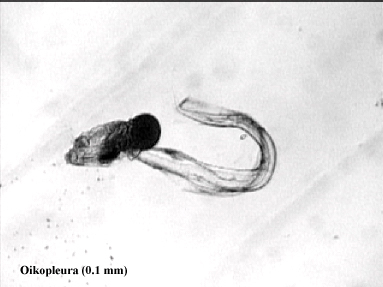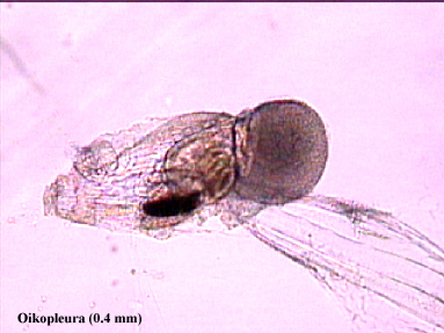Invertebrates
in the Plankton: Chordata
Larvaceans

Like vertebrates,
larvaceans are members of the phylum Chordata, which all share a dorsal
nerve cord, gill slits, and a notochord (stiffening structure in the tail)
at some stage of development. All larvaceans are planktonic.
Oikopleura is a larvacean that feeds by secreting an elaborate
mucous house around itself, which is used to trap small invertebrates.
The house has paired incurrent openings covered with a filter. The filter
keeps out unwanted large organisms and lets in smaller invertebrates which
are sucked into the pharynx.
Oikopleura sits
inside its house beating its tail to propel itself through the water. The
current forces water and food in. The house often becomes clogged with
waste and then a new mucous house must be secreted. This same house protects
the organism and keeps it from sinking in the water column.
The house is a fragile
structure, and it takes a skilled planktonic biologist to collect the animal
with its house intact.
Sexual reproduction
in Oikopleura occurs by the release of sperm through tiny ducts
and the rupture of the body wall to release eggs. All larvaceans are hermaphroditic,
but self fertilization does not occurs. In the photos on this page,
gonads are stored in the large globose structure at the end of the body.
Oikopluera die soon after reproducing.
 Plankton
Home Annelida
Arthropoda
Chaetognatha
Cnidaria & Ctenophora
Echinodermata
Mollusca Invertebrates
2000
Plankton
Home Annelida
Arthropoda
Chaetognatha
Cnidaria & Ctenophora
Echinodermata
Mollusca Invertebrates
2000

